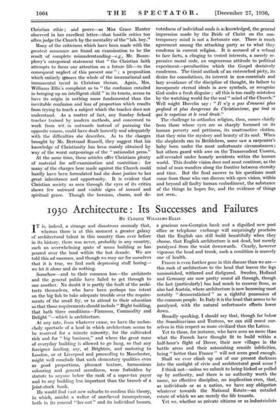193o Architecture : Its Successes and Failures
BY CLOUGH WILLIAMS-ELLIS
IT is, indeed, a strange and disastrous anomaly that, whereas there is at this moment a greater galaxy of architectural talent in this country than ever before in its history, there was never, probably in any country, such an overwhelming spate of mean building as has poured over the land within the last decade. We arc told this ad nauseam, and though we may see for ourselves that it is true, we find such depressing stuff boring— we let it alone and do nothing.
Somehow—and to their common loss—the architects and the general public have failed to get through to one another. No doubt it is partly the fault of the archi- tects themselves, who have been perhaps too intent on the big fish to take adequate trouble over the require- ments of the small fry, or to attend to their education so that those requirements should include " Right building, that hath three conditions—Firmness, Commodity and Delight "—which is architecture.
At any rate, from whatever cause, we have the melan- choly spectacle of a land in which architecture seems to be reserved for a minute minority, for the cultivated rich and for " big business," and where the great mass of everyday building is allowed to go hang, so that any foreigner landing, say, at Brighton, and motoring to London, or at Liverpool and proceeding to Manchester, might well conclude that such elementary qualities even as good proportions, pleasant texture, harmonious colouring and general seemliness, were forbidden by statute to anyone below the rank of a super-tax payer and to any building less important than the branch of a joint-stock bank.
He would find vast new suburbs to confirm this theory, in which, amidst a welter of unrelieved incompetence, both in its eeneral "lay-out" and its individual houses. a gracious neo-Georgian bank and a dignified new post office or telephone exchange will surprisingly proclaim that the English can still build beautifully when they choose, that English architecture is not dead, but merely paralysed from the waist downwards. Clearly, however vigorous the head and trunk, such a condition is scarcely one of health.
France is even further gone in this disease than we are— this rush of architecture to the head that leaves the legs unnourished, withered and disfigured. Sweden, Holland and Germany are now pretty sound all through, though the last (particularly) has had much to recover from, as also had Austria, where architecture is now becoming most notably " democraticized " as a rightful possession of the common people. In Italy it is the head that seems to be paralysed, with the natural unfortunate effects lower down.
Broadly speaking, I should say that, though far below the Scandinavians and Teutons, we can still count our- selves in this respect as more civilized than the Latins.
Yet to those, for instance, who have seen no more than what the French have thought fit to build within a half-hour's flight of Dover, their new villages in the battle areas and their astonishing seaside infelicities, being " better than France " will not seem good enough.
Shall we ever climb up out of our present darkness into the sunlight of civic and architectural good sense ?
I think not—unless we submit to being kicked or pulled up by authority, and there is no authority worth the name, no effective discipline, no implication even, that, as individuals or as a nation, we have any obligation whatever towards the National Estate—an entailed estate of which we are merely the life tenants.
Yet we, whether as private citizens or as industrialists
or speculating development companies, as municipalities or Government Departments (e.g., the War Office and Air Force), are free to build as we like and where we like, with none but the most grotesquely inadequate checks upon our selfish squandering of the national assets, whether in " Commodity " or " Delight."
Already our hugger-mugger carelessness has seriously depreciated the value of our property, or at any rate gravely prejudiced its future value, whilst in the tangled growths which we are allowing to spring up around our already congested towns, we are bequeathing a problem to our unhappy heirs that may prove insoluble without invasion or an earthquake to help them. Some of us see in a " Board of Amenity " (already suggested in the Spectator) the only hope of securing a more civilized background to our ordinary everyday lives—a hope that is still distressingly dim.
But enough of our failures. As to our successes, they are almost entirely in the realm of great commercial or municipal undertakings, varying—so far as London is concerned—in degree and in quality from the refreshing austerities of the Underground Railway building at St. Jamis's Park to the effective pomposities of Imperial Chemicals House at Millbank. There is scarcely a street in the City that does not dazzle us with some vast white pile, the new home of Bank or Insurance office—all of them " handsome," some of them architecturally notable. In the West End, hardly a street but can show its new shops or stores, hotels or blocks of flats, again all built with lavishness and some with distinction. If many of them appear to be rather ungainly mongrels —daring " crosses " that have not quite come off—they are at any rate vigorous puppies from which we may one day breed something that is a little clearer as to its intentions. The present time is where past and future meet, which is why even architecture (if it is alive) always was, is now, and ever shall be, in something of a muddle. If you fix a tradition, it dies and becomes only a legend. There is a real vitality in our archi- tecture to-day because it has new and definite aims, however fumblingly we may express them, however foolishly we may mix up the new forms with the old.



































 Previous page
Previous page